An Essay on Leadership in Public Health: Models, Practice, and Change
VerifiedAdded on 2023/01/05
|8
|2186
|24
Essay
AI Summary
This essay critically examines the concept of leadership and various leadership models, focusing on their application within public health practice. It explores organizational change theories, such as Lewin's three-step model and Kotter's eight-step model, and their significance in healthcare settings. The essay delves into the Healthcare Leadership Model and Covey's 7 habits model, evaluating their strengths and weaknesses. It also discusses the role of public health leadership in driving community-based programs and promoting health. The importance of skills like political astuteness and transformational leadership is highlighted, along with the need for leaders to adapt to change and envision the future. The essay concludes by emphasizing the crucial link between effective leadership, strategic thinking, and a clear vision in achieving public health goals, while also addressing challenges such as poor leadership and communication within healthcare systems. The paper references various journals and books to support the arguments made.
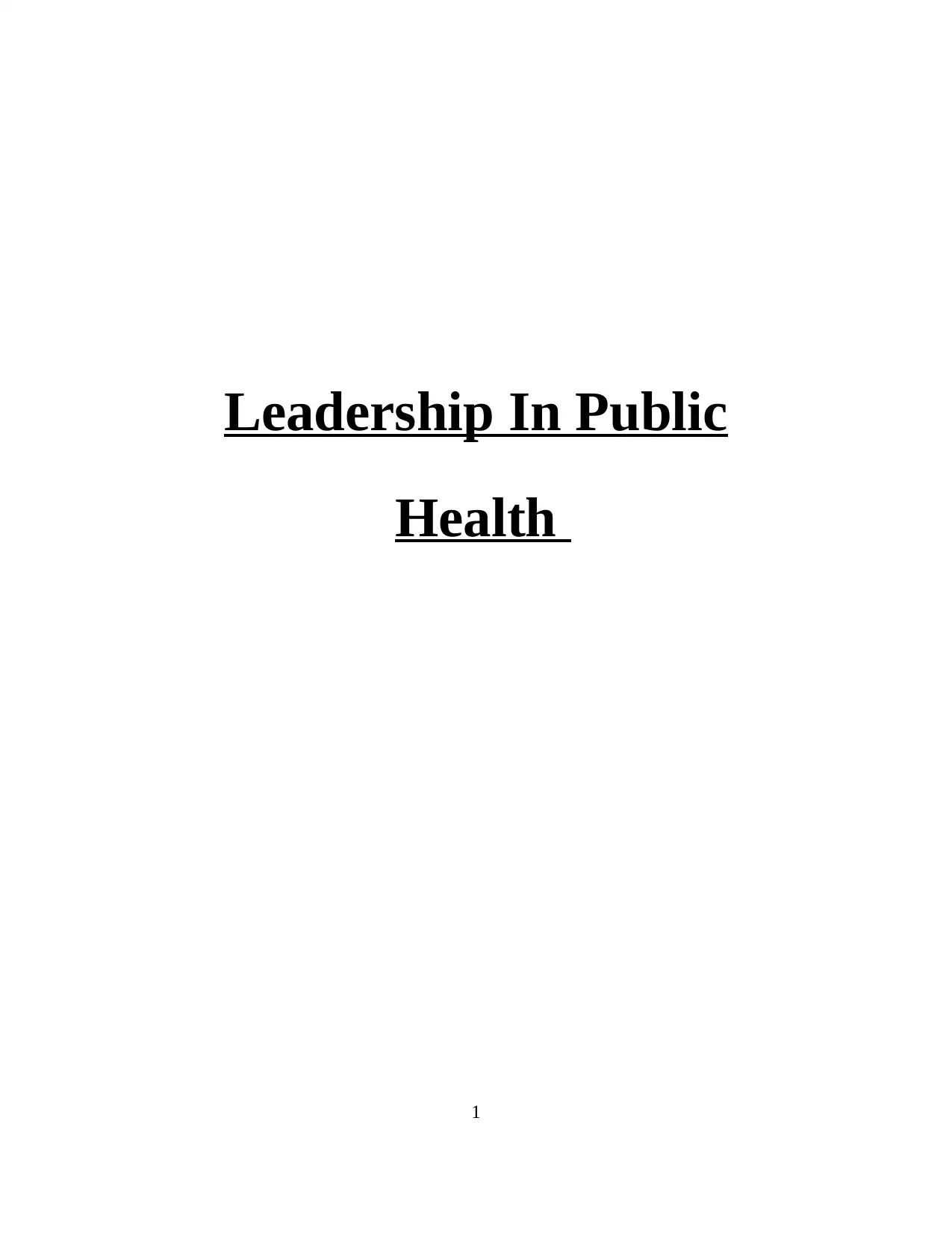
Leadership In Public
Health
1
Health
1
Paraphrase This Document
Need a fresh take? Get an instant paraphrase of this document with our AI Paraphraser
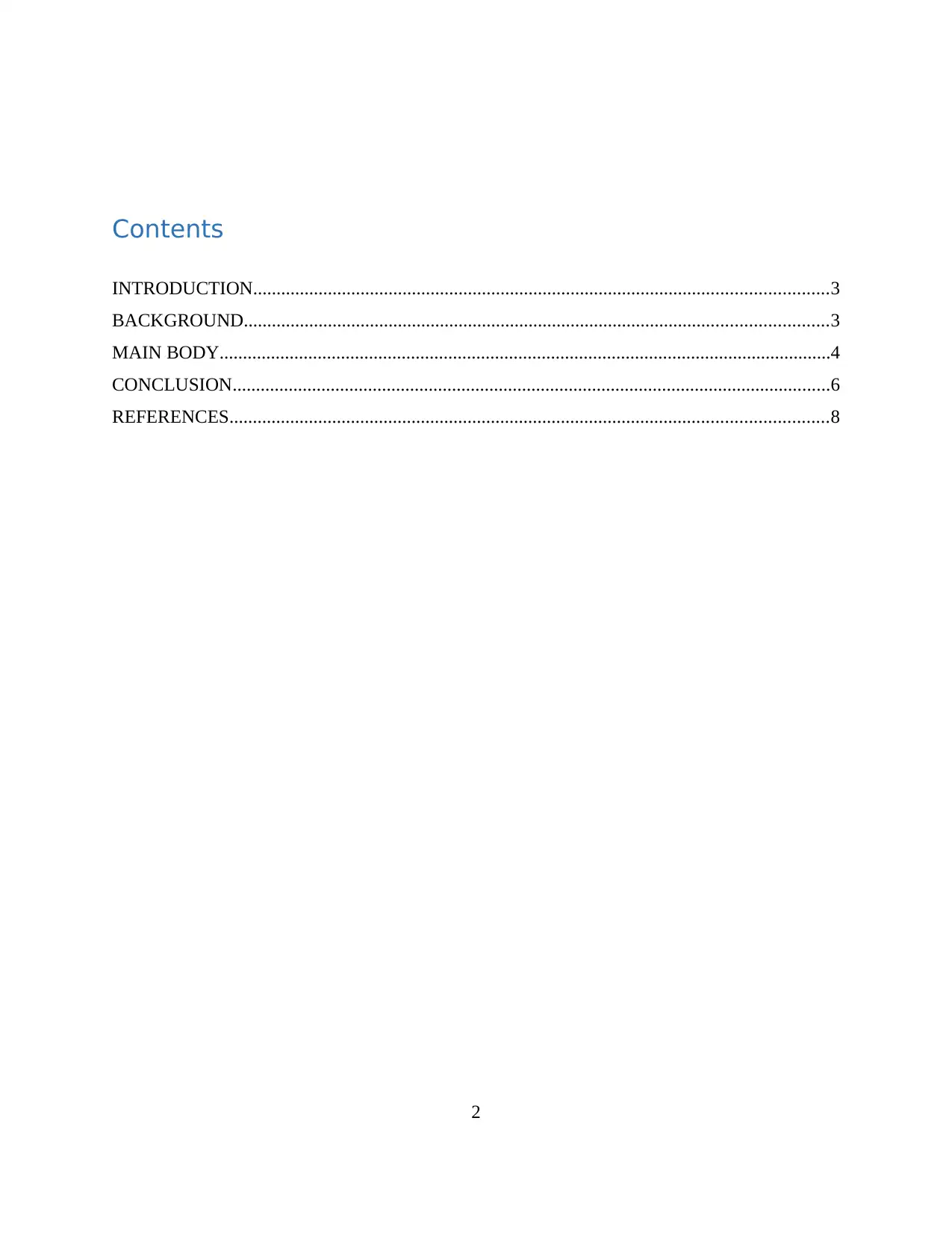
Contents
INTRODUCTION...........................................................................................................................3
BACKGROUND.............................................................................................................................3
MAIN BODY...................................................................................................................................4
CONCLUSION................................................................................................................................6
REFERENCES................................................................................................................................8
2
INTRODUCTION...........................................................................................................................3
BACKGROUND.............................................................................................................................3
MAIN BODY...................................................................................................................................4
CONCLUSION................................................................................................................................6
REFERENCES................................................................................................................................8
2
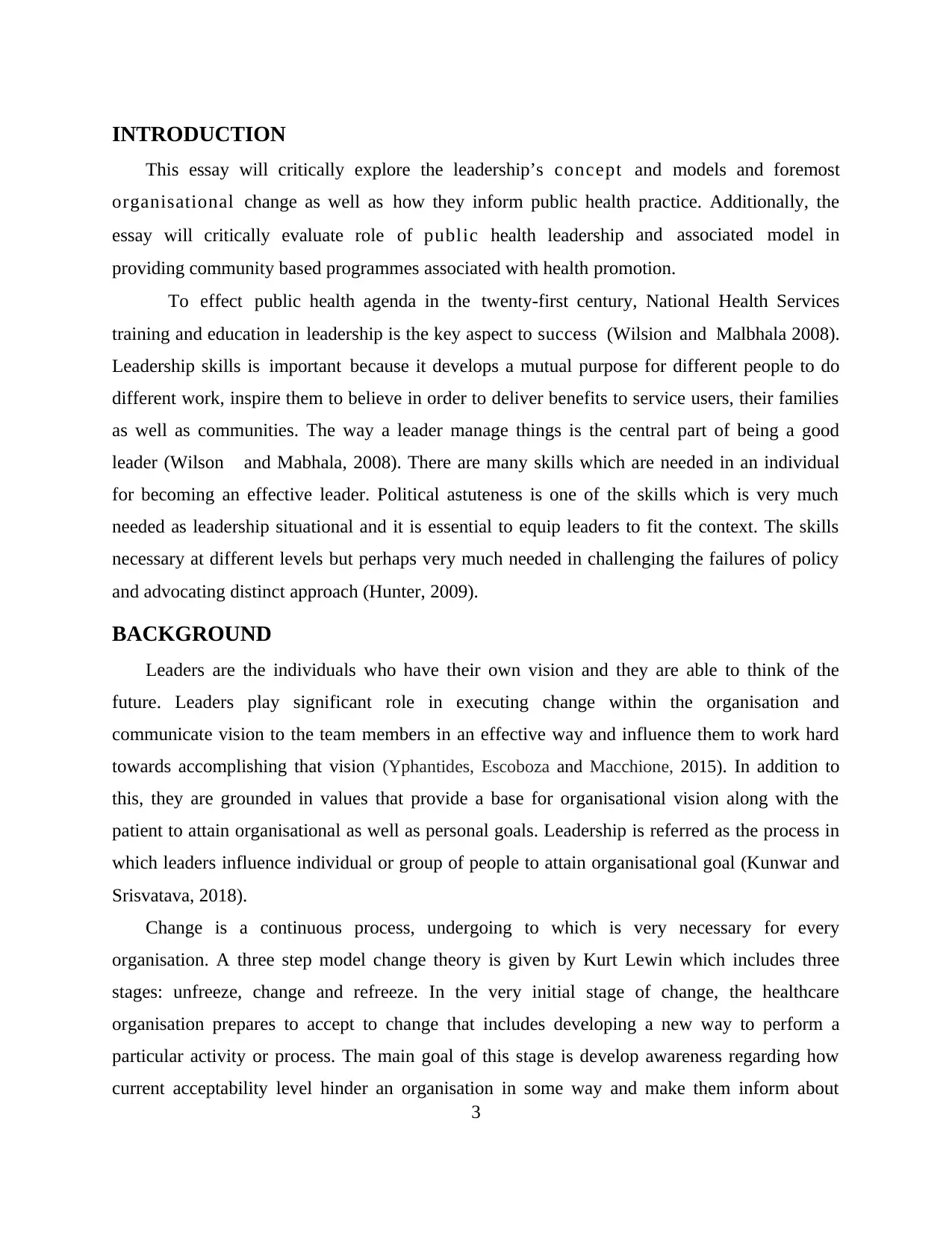
INTRODUCTION
This essay will critically explore the leadership’s concept and models and foremost
organisational change as well as how they inform public health practice. Additionally, the
essay will critically evaluate role of public health leadership and associated model in
providing community based programmes associated with health promotion.
To effect public health agenda in the twenty-first century, National Health Services
training and education in leadership is the key aspect to success (Wilsion and Malbhala 2008).
Leadership skills is important because it develops a mutual purpose for different people to do
different work, inspire them to believe in order to deliver benefits to service users, their families
as well as communities. The way a leader manage things is the central part of being a good
leader (Wilson and Mabhala, 2008). There are many skills which are needed in an individual
for becoming an effective leader. Political astuteness is one of the skills which is very much
needed as leadership situational and it is essential to equip leaders to fit the context. The skills
necessary at different levels but perhaps very much needed in challenging the failures of policy
and advocating distinct approach (Hunter, 2009).
BACKGROUND
Leaders are the individuals who have their own vision and they are able to think of the
future. Leaders play significant role in executing change within the organisation and
communicate vision to the team members in an effective way and influence them to work hard
towards accomplishing that vision (Yphantides, Escoboza and Macchione, 2015). In addition to
this, they are grounded in values that provide a base for organisational vision along with the
patient to attain organisational as well as personal goals. Leadership is referred as the process in
which leaders influence individual or group of people to attain organisational goal (Kunwar and
Srisvatava, 2018).
Change is a continuous process, undergoing to which is very necessary for every
organisation. A three step model change theory is given by Kurt Lewin which includes three
stages: unfreeze, change and refreeze. In the very initial stage of change, the healthcare
organisation prepares to accept to change that includes developing a new way to perform a
particular activity or process. The main goal of this stage is develop awareness regarding how
current acceptability level hinder an organisation in some way and make them inform about
3
This essay will critically explore the leadership’s concept and models and foremost
organisational change as well as how they inform public health practice. Additionally, the
essay will critically evaluate role of public health leadership and associated model in
providing community based programmes associated with health promotion.
To effect public health agenda in the twenty-first century, National Health Services
training and education in leadership is the key aspect to success (Wilsion and Malbhala 2008).
Leadership skills is important because it develops a mutual purpose for different people to do
different work, inspire them to believe in order to deliver benefits to service users, their families
as well as communities. The way a leader manage things is the central part of being a good
leader (Wilson and Mabhala, 2008). There are many skills which are needed in an individual
for becoming an effective leader. Political astuteness is one of the skills which is very much
needed as leadership situational and it is essential to equip leaders to fit the context. The skills
necessary at different levels but perhaps very much needed in challenging the failures of policy
and advocating distinct approach (Hunter, 2009).
BACKGROUND
Leaders are the individuals who have their own vision and they are able to think of the
future. Leaders play significant role in executing change within the organisation and
communicate vision to the team members in an effective way and influence them to work hard
towards accomplishing that vision (Yphantides, Escoboza and Macchione, 2015). In addition to
this, they are grounded in values that provide a base for organisational vision along with the
patient to attain organisational as well as personal goals. Leadership is referred as the process in
which leaders influence individual or group of people to attain organisational goal (Kunwar and
Srisvatava, 2018).
Change is a continuous process, undergoing to which is very necessary for every
organisation. A three step model change theory is given by Kurt Lewin which includes three
stages: unfreeze, change and refreeze. In the very initial stage of change, the healthcare
organisation prepares to accept to change that includes developing a new way to perform a
particular activity or process. The main goal of this stage is develop awareness regarding how
current acceptability level hinder an organisation in some way and make them inform about
3
⊘ This is a preview!⊘
Do you want full access?
Subscribe today to unlock all pages.

Trusted by 1+ million students worldwide
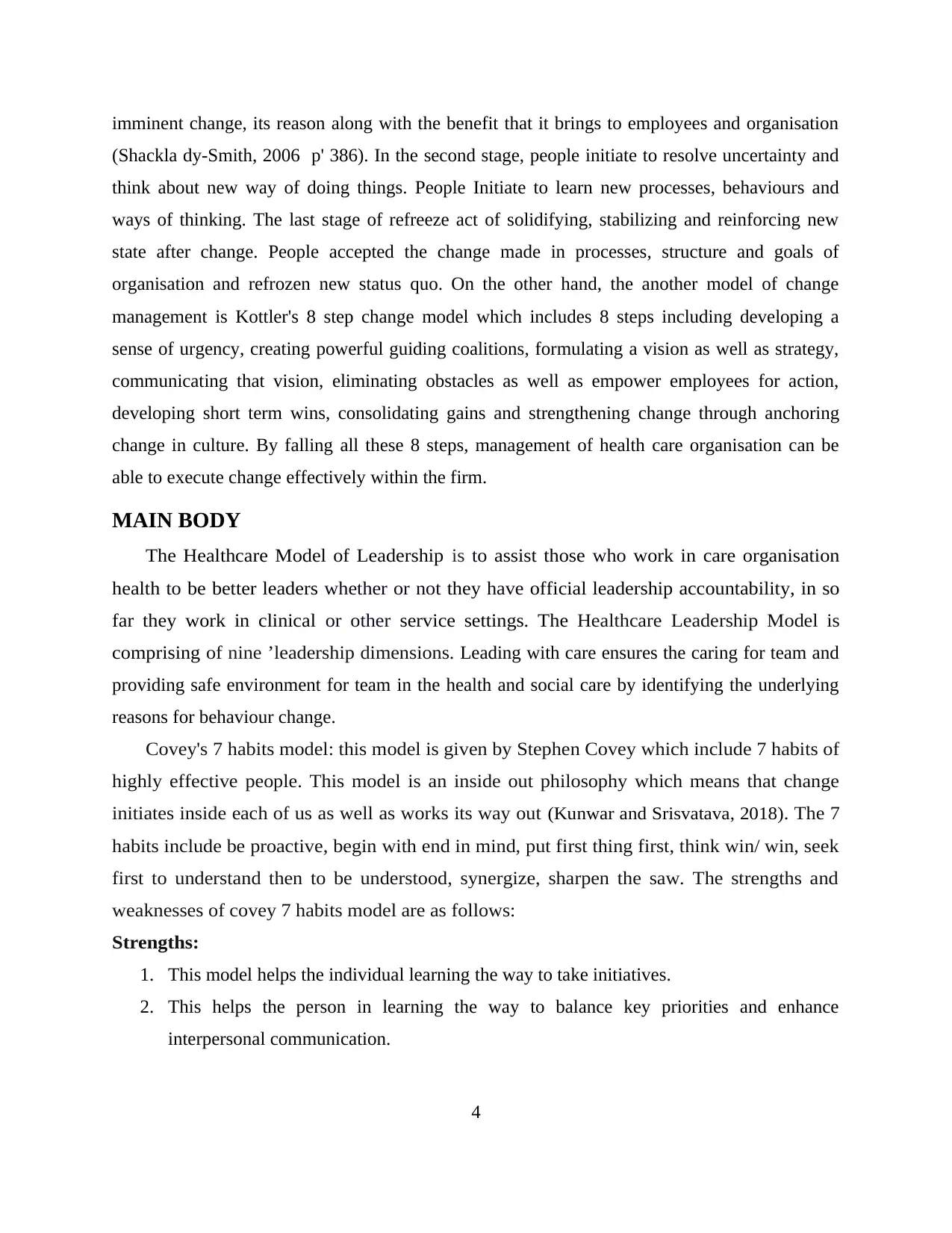
imminent change, its reason along with the benefit that it brings to employees and organisation
(Shackla dy-Smith, 2006 p' 386). In the second stage, people initiate to resolve uncertainty and
think about new way of doing things. People Initiate to learn new processes, behaviours and
ways of thinking. The last stage of refreeze act of solidifying, stabilizing and reinforcing new
state after change. People accepted the change made in processes, structure and goals of
organisation and refrozen new status quo. On the other hand, the another model of change
management is Kottler's 8 step change model which includes 8 steps including developing a
sense of urgency, creating powerful guiding coalitions, formulating a vision as well as strategy,
communicating that vision, eliminating obstacles as well as empower employees for action,
developing short term wins, consolidating gains and strengthening change through anchoring
change in culture. By falling all these 8 steps, management of health care organisation can be
able to execute change effectively within the firm.
MAIN BODY
The Healthcare Model of Leadership is to assist those who work in care organisation
health to be better leaders whether or not they have official leadership accountability, in so
far they work in clinical or other service settings. The Healthcare Leadership Model is
comprising of nine ’leadership dimensions. Leading with care ensures the caring for team and
providing safe environment for team in the health and social care by identifying the underlying
reasons for behaviour change.
Covey's 7 habits model: this model is given by Stephen Covey which include 7 habits of
highly effective people. This model is an inside out philosophy which means that change
initiates inside each of us as well as works its way out (Kunwar and Srisvatava, 2018) . The 7
habits include be proactive, begin with end in mind, put first thing first, think win/ win, seek
first to understand then to be understood, synergize, sharpen the saw. The strengths and
weaknesses of covey 7 habits model are as follows:
Strengths:
1. This model helps the individual learning the way to take initiatives.
2. This helps the person in learning the way to balance key priorities and enhance
interpersonal communication.
4
(Shackla dy-Smith, 2006 p' 386). In the second stage, people initiate to resolve uncertainty and
think about new way of doing things. People Initiate to learn new processes, behaviours and
ways of thinking. The last stage of refreeze act of solidifying, stabilizing and reinforcing new
state after change. People accepted the change made in processes, structure and goals of
organisation and refrozen new status quo. On the other hand, the another model of change
management is Kottler's 8 step change model which includes 8 steps including developing a
sense of urgency, creating powerful guiding coalitions, formulating a vision as well as strategy,
communicating that vision, eliminating obstacles as well as empower employees for action,
developing short term wins, consolidating gains and strengthening change through anchoring
change in culture. By falling all these 8 steps, management of health care organisation can be
able to execute change effectively within the firm.
MAIN BODY
The Healthcare Model of Leadership is to assist those who work in care organisation
health to be better leaders whether or not they have official leadership accountability, in so
far they work in clinical or other service settings. The Healthcare Leadership Model is
comprising of nine ’leadership dimensions. Leading with care ensures the caring for team and
providing safe environment for team in the health and social care by identifying the underlying
reasons for behaviour change.
Covey's 7 habits model: this model is given by Stephen Covey which include 7 habits of
highly effective people. This model is an inside out philosophy which means that change
initiates inside each of us as well as works its way out (Kunwar and Srisvatava, 2018) . The 7
habits include be proactive, begin with end in mind, put first thing first, think win/ win, seek
first to understand then to be understood, synergize, sharpen the saw. The strengths and
weaknesses of covey 7 habits model are as follows:
Strengths:
1. This model helps the individual learning the way to take initiatives.
2. This helps the person in learning the way to balance key priorities and enhance
interpersonal communication.
4
Paraphrase This Document
Need a fresh take? Get an instant paraphrase of this document with our AI Paraphraser
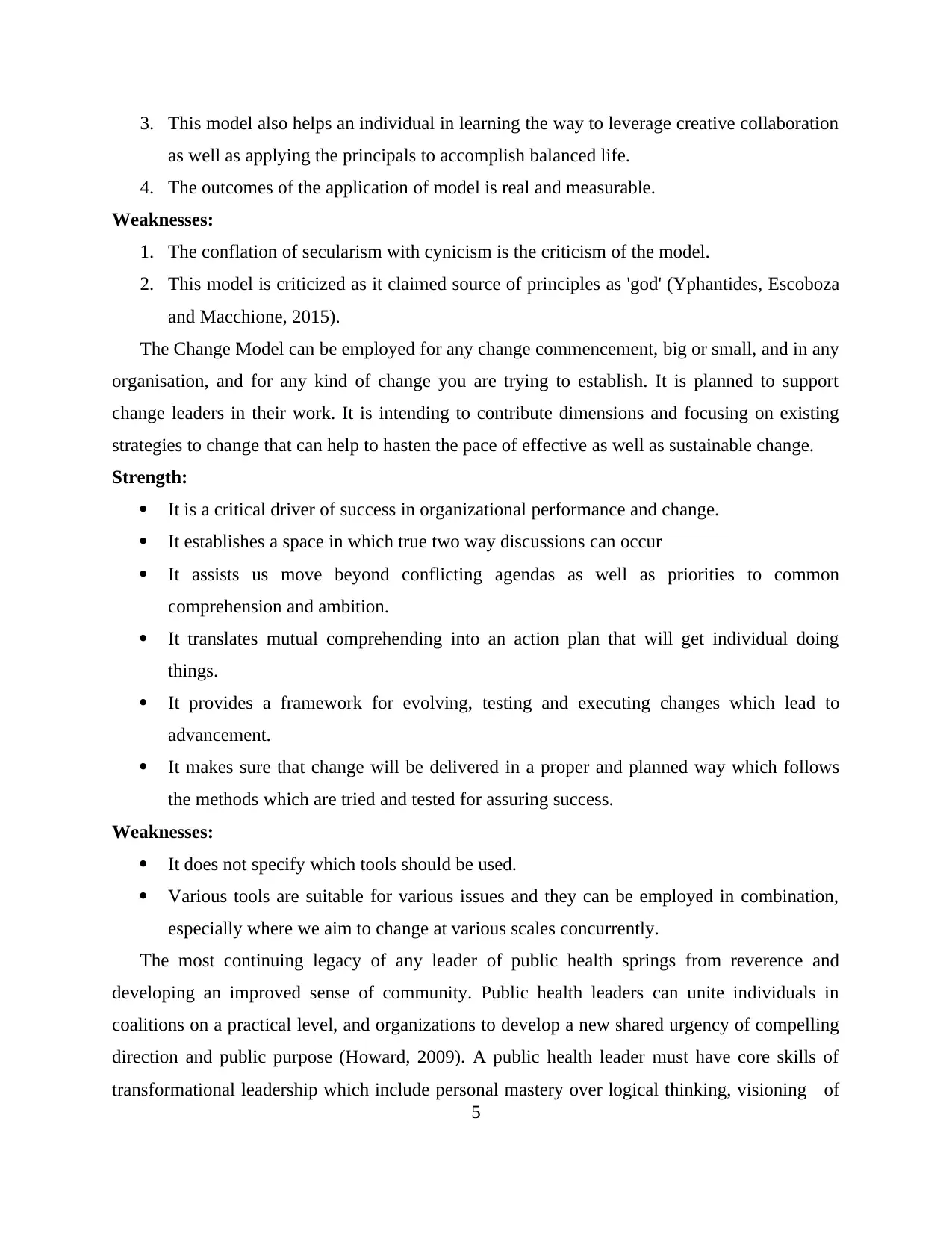
3. This model also helps an individual in learning the way to leverage creative collaboration
as well as applying the principals to accomplish balanced life.
4. The outcomes of the application of model is real and measurable.
Weaknesses:
1. The conflation of secularism with cynicism is the criticism of the model.
2. This model is criticized as it claimed source of principles as 'god' (Yphantides, Escoboza
and Macchione, 2015).
The Change Model can be employed for any change commencement, big or small, and in any
organisation, and for any kind of change you are trying to establish. It is planned to support
change leaders in their work. It is intending to contribute dimensions and focusing on existing
strategies to change that can help to hasten the pace of effective as well as sustainable change.
Strength:
It is a critical driver of success in organizational performance and change.
It establishes a space in which true two way discussions can occur
It assists us move beyond conflicting agendas as well as priorities to common
comprehension and ambition.
It translates mutual comprehending into an action plan that will get individual doing
things.
It provides a framework for evolving, testing and executing changes which lead to
advancement.
It makes sure that change will be delivered in a proper and planned way which follows
the methods which are tried and tested for assuring success.
Weaknesses:
It does not specify which tools should be used.
Various tools are suitable for various issues and they can be employed in combination,
especially where we aim to change at various scales concurrently.
The most continuing legacy of any leader of public health springs from reverence and
developing an improved sense of community. Public health leaders can unite individuals in
coalitions on a practical level, and organizations to develop a new shared urgency of compelling
direction and public purpose (Howard, 2009). A public health leader must have core skills of
transformational leadership which include personal mastery over logical thinking, visioning of
5
as well as applying the principals to accomplish balanced life.
4. The outcomes of the application of model is real and measurable.
Weaknesses:
1. The conflation of secularism with cynicism is the criticism of the model.
2. This model is criticized as it claimed source of principles as 'god' (Yphantides, Escoboza
and Macchione, 2015).
The Change Model can be employed for any change commencement, big or small, and in any
organisation, and for any kind of change you are trying to establish. It is planned to support
change leaders in their work. It is intending to contribute dimensions and focusing on existing
strategies to change that can help to hasten the pace of effective as well as sustainable change.
Strength:
It is a critical driver of success in organizational performance and change.
It establishes a space in which true two way discussions can occur
It assists us move beyond conflicting agendas as well as priorities to common
comprehension and ambition.
It translates mutual comprehending into an action plan that will get individual doing
things.
It provides a framework for evolving, testing and executing changes which lead to
advancement.
It makes sure that change will be delivered in a proper and planned way which follows
the methods which are tried and tested for assuring success.
Weaknesses:
It does not specify which tools should be used.
Various tools are suitable for various issues and they can be employed in combination,
especially where we aim to change at various scales concurrently.
The most continuing legacy of any leader of public health springs from reverence and
developing an improved sense of community. Public health leaders can unite individuals in
coalitions on a practical level, and organizations to develop a new shared urgency of compelling
direction and public purpose (Howard, 2009). A public health leader must have core skills of
transformational leadership which include personal mastery over logical thinking, visioning of
5
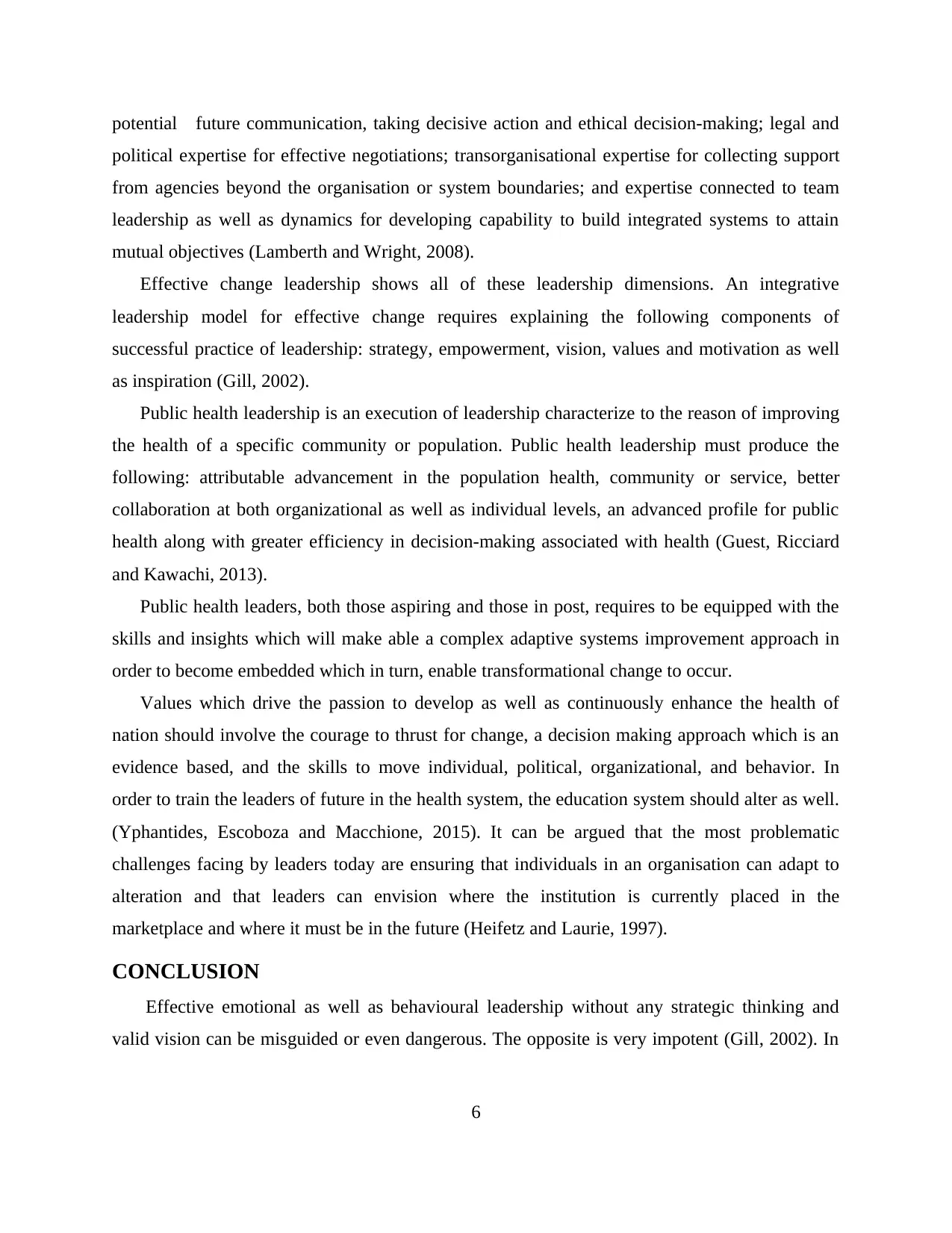
potential future communication, taking decisive action and ethical decision-making; legal and
political expertise for effective negotiations; transorganisational expertise for collecting support
from agencies beyond the organisation or system boundaries; and expertise connected to team
leadership as well as dynamics for developing capability to build integrated systems to attain
mutual objectives (Lamberth and Wright, 2008).
Effective change leadership shows all of these leadership dimensions. An integrative
leadership model for effective change requires explaining the following components of
successful practice of leadership: strategy, empowerment, vision, values and motivation as well
as inspiration (Gill, 2002).
Public health leadership is an execution of leadership characterize to the reason of improving
the health of a specific community or population. Public health leadership must produce the
following: attributable advancement in the population health, community or service, better
collaboration at both organizational as well as individual levels, an advanced profile for public
health along with greater efficiency in decision-making associated with health (Guest, Ricciard
and Kawachi, 2013).
Public health leaders, both those aspiring and those in post, requires to be equipped with the
skills and insights which will make able a complex adaptive systems improvement approach in
order to become embedded which in turn, enable transformational change to occur.
Values which drive the passion to develop as well as continuously enhance the health of
nation should involve the courage to thrust for change, a decision making approach which is an
evidence based, and the skills to move individual, political, organizational, and behavior. In
order to train the leaders of future in the health system, the education system should alter as well.
(Yphantides, Escoboza and Macchione, 2015). It can be argued that the most problematic
challenges facing by leaders today are ensuring that individuals in an organisation can adapt to
alteration and that leaders can envision where the institution is currently placed in the
marketplace and where it must be in the future (Heifetz and Laurie, 1997).
CONCLUSION
Effective emotional as well as behavioural leadership without any strategic thinking and
valid vision can be misguided or even dangerous. The opposite is very impotent (Gill, 2002). In
6
political expertise for effective negotiations; transorganisational expertise for collecting support
from agencies beyond the organisation or system boundaries; and expertise connected to team
leadership as well as dynamics for developing capability to build integrated systems to attain
mutual objectives (Lamberth and Wright, 2008).
Effective change leadership shows all of these leadership dimensions. An integrative
leadership model for effective change requires explaining the following components of
successful practice of leadership: strategy, empowerment, vision, values and motivation as well
as inspiration (Gill, 2002).
Public health leadership is an execution of leadership characterize to the reason of improving
the health of a specific community or population. Public health leadership must produce the
following: attributable advancement in the population health, community or service, better
collaboration at both organizational as well as individual levels, an advanced profile for public
health along with greater efficiency in decision-making associated with health (Guest, Ricciard
and Kawachi, 2013).
Public health leaders, both those aspiring and those in post, requires to be equipped with the
skills and insights which will make able a complex adaptive systems improvement approach in
order to become embedded which in turn, enable transformational change to occur.
Values which drive the passion to develop as well as continuously enhance the health of
nation should involve the courage to thrust for change, a decision making approach which is an
evidence based, and the skills to move individual, political, organizational, and behavior. In
order to train the leaders of future in the health system, the education system should alter as well.
(Yphantides, Escoboza and Macchione, 2015). It can be argued that the most problematic
challenges facing by leaders today are ensuring that individuals in an organisation can adapt to
alteration and that leaders can envision where the institution is currently placed in the
marketplace and where it must be in the future (Heifetz and Laurie, 1997).
CONCLUSION
Effective emotional as well as behavioural leadership without any strategic thinking and
valid vision can be misguided or even dangerous. The opposite is very impotent (Gill, 2002). In
6
⊘ This is a preview!⊘
Do you want full access?
Subscribe today to unlock all pages.

Trusted by 1+ million students worldwide
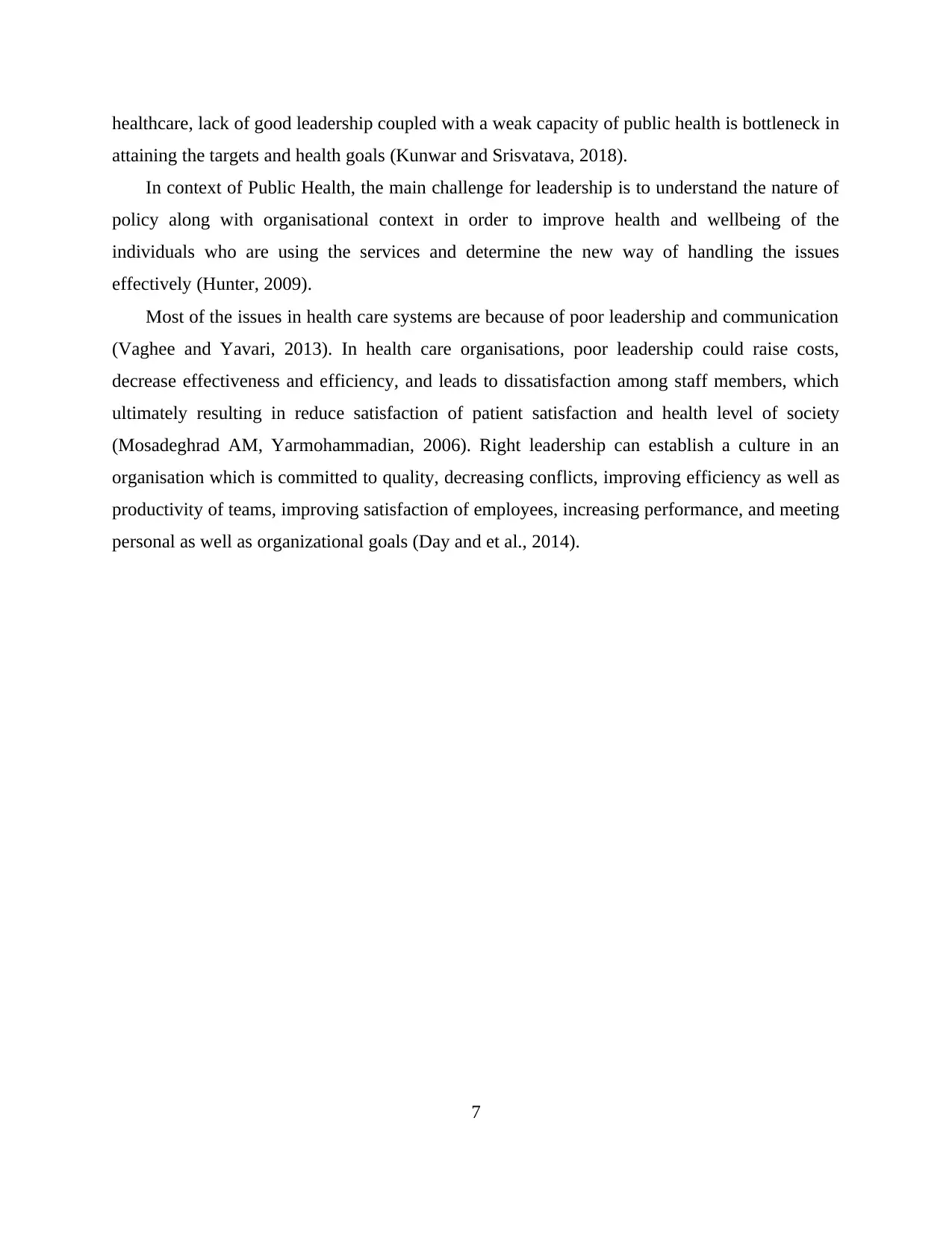
healthcare, lack of good leadership coupled with a weak capacity of public health is bottleneck in
attaining the targets and health goals (Kunwar and Srisvatava, 2018).
In context of Public Health, the main challenge for leadership is to understand the nature of
policy along with organisational context in order to improve health and wellbeing of the
individuals who are using the services and determine the new way of handling the issues
effectively (Hunter, 2009).
Most of the issues in health care systems are because of poor leadership and communication
(Vaghee and Yavari, 2013). In health care organisations, poor leadership could raise costs,
decrease effectiveness and efficiency, and leads to dissatisfaction among staff members, which
ultimately resulting in reduce satisfaction of patient satisfaction and health level of society
(Mosadeghrad AM, Yarmohammadian, 2006). Right leadership can establish a culture in an
organisation which is committed to quality, decreasing conflicts, improving efficiency as well as
productivity of teams, improving satisfaction of employees, increasing performance, and meeting
personal as well as organizational goals (Day and et al., 2014).
7
attaining the targets and health goals (Kunwar and Srisvatava, 2018).
In context of Public Health, the main challenge for leadership is to understand the nature of
policy along with organisational context in order to improve health and wellbeing of the
individuals who are using the services and determine the new way of handling the issues
effectively (Hunter, 2009).
Most of the issues in health care systems are because of poor leadership and communication
(Vaghee and Yavari, 2013). In health care organisations, poor leadership could raise costs,
decrease effectiveness and efficiency, and leads to dissatisfaction among staff members, which
ultimately resulting in reduce satisfaction of patient satisfaction and health level of society
(Mosadeghrad AM, Yarmohammadian, 2006). Right leadership can establish a culture in an
organisation which is committed to quality, decreasing conflicts, improving efficiency as well as
productivity of teams, improving satisfaction of employees, increasing performance, and meeting
personal as well as organizational goals (Day and et al., 2014).
7
Paraphrase This Document
Need a fresh take? Get an instant paraphrase of this document with our AI Paraphraser
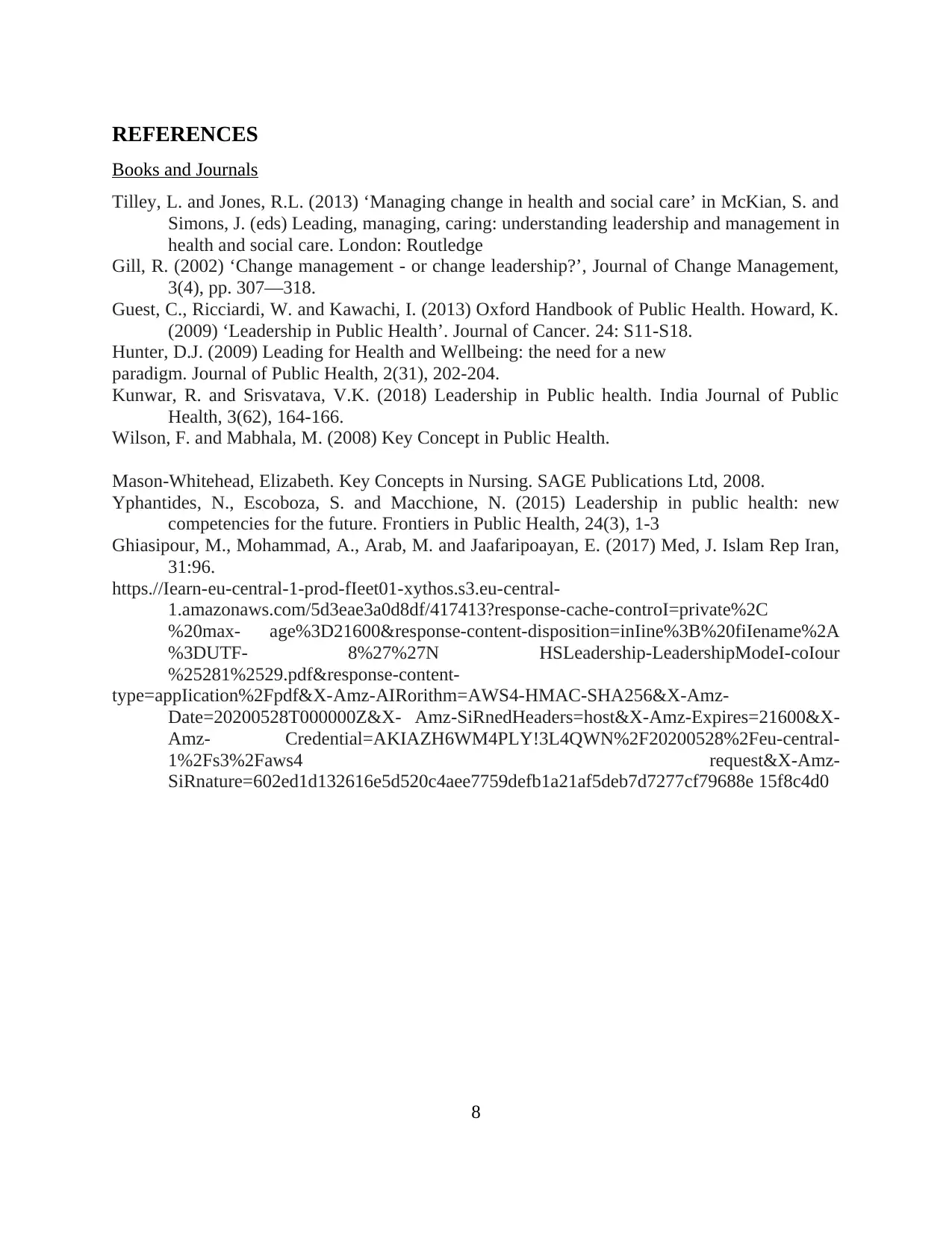
REFERENCES
Books and Journals
Tilley, L. and Jones, R.L. (2013) ‘Managing change in health and social care’ in McKian, S. and
Simons, J. (eds) Leading, managing, caring: understanding leadership and management in
health and social care. London: Routledge
Gill, R. (2002) ‘Change management - or change leadership?’, Journal of Change Management,
3(4), pp. 307—318.
Guest, C., Ricciardi, W. and Kawachi, I. (2013) Oxford Handbook of Public Health. Howard, K.
(2009) ‘Leadership in Public Health’. Journal of Cancer. 24: S11-S18.
Hunter, D.J. (2009) Leading for Health and Wellbeing: the need for a new
paradigm. Journal of Public Health, 2(31), 202-204.
Kunwar, R. and Srisvatava, V.K. (2018) Leadership in Public health. India Journal of Public
Health, 3(62), 164-166.
Wilson, F. and Mabhala, M. (2008) Key Concept in Public Health.
Mason-Whitehead, Elizabeth. Key Concepts in Nursing. SAGE Publications Ltd, 2008.
Yphantides, N., Escoboza, S. and Macchione, N. (2015) Leadership in public health: new
competencies for the future. Frontiers in Public Health, 24(3), 1-3
Ghiasipour, M., Mohammad, A., Arab, M. and Jaafaripoayan, E. (2017) Med, J. Islam Rep Iran,
31:96.
https.//Iearn-eu-central-1-prod-fIeet01-xythos.s3.eu-central-
1.amazonaws.com/5d3eae3a0d8df/417413?response-cache-controI=private%2C
%20max- age%3D21600&response-content-disposition=inIine%3B%20fiIename%2A
%3DUTF- 8%27%27N HSLeadership-LeadershipModeI-coIour
%25281%2529.pdf&response-content-
type=appIication%2Fpdf&X-Amz-AIRorithm=AWS4-HMAC-SHA256&X-Amz-
Date=20200528T000000Z&X- Amz-SiRnedHeaders=host&X-Amz-Expires=21600&X-
Amz- Credential=AKIAZH6WM4PLY!3L4QWN%2F20200528%2Feu-central-
1%2Fs3%2Faws4 request&X-Amz-
SiRnature=602ed1d132616e5d520c4aee7759defb1a21af5deb7d7277cf79688e 15f8c4d0
8
Books and Journals
Tilley, L. and Jones, R.L. (2013) ‘Managing change in health and social care’ in McKian, S. and
Simons, J. (eds) Leading, managing, caring: understanding leadership and management in
health and social care. London: Routledge
Gill, R. (2002) ‘Change management - or change leadership?’, Journal of Change Management,
3(4), pp. 307—318.
Guest, C., Ricciardi, W. and Kawachi, I. (2013) Oxford Handbook of Public Health. Howard, K.
(2009) ‘Leadership in Public Health’. Journal of Cancer. 24: S11-S18.
Hunter, D.J. (2009) Leading for Health and Wellbeing: the need for a new
paradigm. Journal of Public Health, 2(31), 202-204.
Kunwar, R. and Srisvatava, V.K. (2018) Leadership in Public health. India Journal of Public
Health, 3(62), 164-166.
Wilson, F. and Mabhala, M. (2008) Key Concept in Public Health.
Mason-Whitehead, Elizabeth. Key Concepts in Nursing. SAGE Publications Ltd, 2008.
Yphantides, N., Escoboza, S. and Macchione, N. (2015) Leadership in public health: new
competencies for the future. Frontiers in Public Health, 24(3), 1-3
Ghiasipour, M., Mohammad, A., Arab, M. and Jaafaripoayan, E. (2017) Med, J. Islam Rep Iran,
31:96.
https.//Iearn-eu-central-1-prod-fIeet01-xythos.s3.eu-central-
1.amazonaws.com/5d3eae3a0d8df/417413?response-cache-controI=private%2C
%20max- age%3D21600&response-content-disposition=inIine%3B%20fiIename%2A
%3DUTF- 8%27%27N HSLeadership-LeadershipModeI-coIour
%25281%2529.pdf&response-content-
type=appIication%2Fpdf&X-Amz-AIRorithm=AWS4-HMAC-SHA256&X-Amz-
Date=20200528T000000Z&X- Amz-SiRnedHeaders=host&X-Amz-Expires=21600&X-
Amz- Credential=AKIAZH6WM4PLY!3L4QWN%2F20200528%2Feu-central-
1%2Fs3%2Faws4 request&X-Amz-
SiRnature=602ed1d132616e5d520c4aee7759defb1a21af5deb7d7277cf79688e 15f8c4d0
8
1 out of 8
Related Documents
Your All-in-One AI-Powered Toolkit for Academic Success.
+13062052269
info@desklib.com
Available 24*7 on WhatsApp / Email
![[object Object]](/_next/static/media/star-bottom.7253800d.svg)
Unlock your academic potential
Copyright © 2020–2025 A2Z Services. All Rights Reserved. Developed and managed by ZUCOL.





